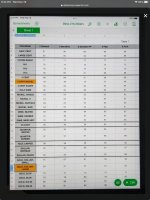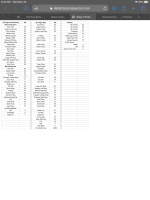I didnt know that. I'm brand new to the frequency change option and so far havnt figured out how to manage the frequency. I want to be lower frequency, hopefully around the 12khz but dont know yet how to acomplish that. I am using the deep(number 6) program for thr lower frequencies but customized it some and enter on number 15 but I dont know if the frequencies stay the same after I customized it. The frequency shift on settings keep shifting. I set it to zero but when I lock it in it goes back to 3.
Find's Treasure Forums
Welcome to Find's Treasure Forums, Guests!
You are viewing this forums as a guest which limits you to read only status.
Only registered members may post stories, questions, classifieds, reply to other posts, contact other members using built in messaging and use many other features found on these forums.
Why not register and join us today? It's free! (We don't share your email addresses with anyone.) We keep email addresses of our users to protect them and others from bad people posting things they shouldn't.
Click here to register!
Need Support Help?
Cannot log in?, click here to have new password emailed to you
Changed email? Forgot to update your account with new email address? Need assistance with something else?, click here to go to Find's Support Form and fill out the form.
You are using an out of date browser. It may not display this or other websites correctly.
You should upgrade or use an alternative browser.
You should upgrade or use an alternative browser.
Input please on upgrading my detector
- Thread starter Fanger
- Start date
Geologyhound
Well-known member
Thanks! I’ve read the manual twice and still didn’t remember that. I guess I’ll read it a couple more times...See page 29 of the manual at the top. On the standard screen is what they call profile, one side ferrous the other non ferrous. On the Deus it is shaped like a horseshoe. On the D2 it looks like two fat upside-down Ls.
The amount of black in either side gives the indication of depth. All black says the target is very close. A small sliver of black says it is deep. There is no inch meter. Your MXT had a sensitivity meter calibrated to American coins. The Deus is designed for European coins which are of a much greater variety. I doubt is possible to even try to tell the depth when a cut coin is so much smaller than their big coins The Deus 1 manual gives a rough estimate of depth according to the amount of black in the profile. You can do the same by comparing the black to the depth you dig.
As for the pinpoint mode, take a flat can and pinpoint on it. Notice the "hot spot" is quite large and it starts to sound off outside the edge of the coil until you retune it. Pinpoint a dime. The hot spot is much smaller and doesn't sound off over near as big an area.
Geologyhound
Well-known member
That is one thing I need to get used to. The VDI numbers are basically subjectively selected by the manufacturer as Picketwire did a good job of explaining. The D2 tends to have higher VDI numbers for some typical targets and a more compressed “good” zone than the White‘s scale we are used to. I have seen some discussion that the compressed area of “good“ VDI numbers on the D2 may also be why the D2 tends to get fairly stable VDI locks on good targets.Great info Geologyhound , the euro coin design may explain why my numbers are higher on the sam targets on the d2 than the mxt. And its a good idea for us to start a thread on Deus forum,
In one of the forums I browsed while trying to decide on a detector, someone had generated a spreadsheet of a number of different targets and how they registered with the different programs. If I can find that again, I’ll leave a reference here.
Picketwire
Well-known member
Numbers are nice but there are a huge amount of things in the ground that make them change from what is expected. (Quote from Heraclitus; "If you do not expect the unexpected you will not find it, for it is not to be reached by search or trail.) Just because a dime gives a certain number in most cases, the numbers can be off high or low depending on the proximity of other objects. Other objects can give the exact dime number too, including big pieces of iron. Learn the sounds. I believe that is one of the things that separate the experts from others.
Geologyhound
Well-known member
Absolutely! I’ve read a number of discussions regarding up averaging and down averaging. Since my first few weeks of detecting, I try to isolate each target as much as possible (if it can be isolated...) so I can get readings off of it only before deciding to dig or not. The chart I’m remembering is just a good baseline. The numbers will fluctuate depending on the program and frequencies in use, neighboring trash, how worn the target is, etc. However knowing that the D2 tends to register nickels in the 60s versus the 20s that I’m used to from the XLT is good information too.Numbers are nice but there are a huge amount of things in the ground that make them change from what is expected. (Quote from Heraclitus; "If you do not expect the unexpected you will not find it, for it is not to be reached by search or trail.) Just because a dime gives a certain number in most cases, the numbers can be off high or low depending on the proximity of other objects. Other objects can give the exact dime number too, including big pieces of iron. Learn the sounds. I believe that is one of the things that separate the experts from others.
Yes and with my MXT I could get a deep hit with a number that may read 50, I could dig several inches of dirt off and It may read 65. About the high and low frequency programs, are they adjustable per program or only by shifting programs?? For example the deep HC - max freq. 14 KHZ. I think I read that it is from 4 to max freq. 14, does that mean that I can adjust the frequency and remain on the deep hc program?
Picketwire
Well-known member
Lots people us numbers to decide whether or not to dig. This is why there is still good targets being found by experts. You have just purchased one of the best detectors on the market but put a quarter and a pull tab an inch or two apart on the ground and see what kind of number you get.. If it tells you that number on top of the ground, consider what it will be buried.
I don't have the D2 but if it is like the original Deus, the answer is yes.does that mean that I can adjust the frequency and remain on the deep hc program?
Geologyhound
Well-known member
There is also a frequency scan function which will find the frequencies with the least interference for each program. Or you can offset the frequency manually.Yes and with my MXT I could get a deep hit with a number that may read 50, I could dig several inches of dirt off and It may read 65. About the high and low frequency programs, are they adjustable per program or only by shifting programs?? For example the deep HC - max freq. 14 KHZ. I think I read that it is from 4 to max freq. 14, does that mean that I can adjust the frequency and remain on the deep hc program?
Geologyhound
Well-known member
Fanger, here are some D2 TID charts. I did not develop these. The chart with three columns was posted by ColonelDan over at detectorprospector.com. He used a custom beach program and air testing. The second chart was posted by JoeInMemphis also at detectorprospector.com. He used stock programs, air testing and sensitivity at 75 to”quiet the chatter”. I won’t pretend to debate the merits of air testing versus in situ targets. So take these with a grain of salt. Depending on your site conditions results may vary... If you find them of use, please log on over there sometime and thank the original poster.


